For my gluten free Coconut Water and Mixed Berries Jelly recipe, I am using all natural ingredients. A combination of coconut water and nutrient rich mixed berries. Including blueberries, raspberries, strawberries and goji berries. Likewise, I added agar agar powder to the coconut water to set the jellies. This Coconut Water and Mixed Berries Jelly recipe is not only gluten free. But also paleo, vegan, dairy free, soy free, nut free, egg free, corn free, low carb and refined sugar free. All the ingredients in this easy Coconut Water and Mixed Berries Jelly dessert makes it a nutritional power house dessert. Read on to find out more.
You may also like my other naturally gluten free pudding recipes:
Types of Agar Agar Jelly
Agar agar Jelly always reminds me of many fond childhood memories of eating different types of homemade Jelly. Commercially available, they come with lots of different fresh fruits and flavours. Besides, they sell many store bought jellies with different colours and flavourings that really have great appeal to young children. Some of my favourites jelly flavours include coconut and pandan, mangoes, lychee, pineapple, almond and palm sugar (gula melaka). As well as strawberries, blueberries, raspberries and rainbow colours jelly.
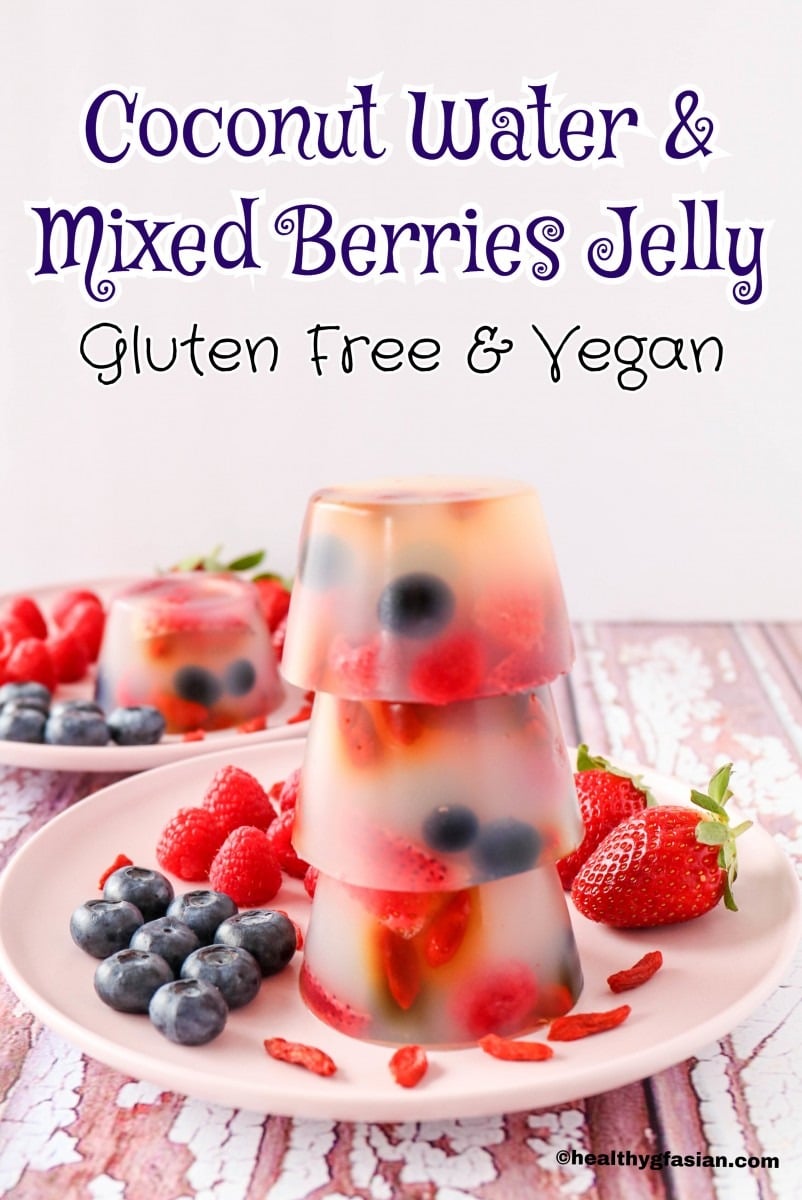
What is Agar Agar?
So, what is agar? They derive Agar Jelly (also known as agar agar) mainly from red algae or seaweed (Gelidium and Gracilaria). It is also a vegan substitute for gelatin (a derivative of animal collagen). In Japan, they call agar Kanten and China grass in India. While agar agar is a Malay word meaning jelly. According to folktale, a Japanese innkeeper, named Mino Tarozaemon discovered agar. All the way back in 1658 in Japan. Besides, he threw away some leftover seaweed soup and became aware that it thickened and coagulated. After an overnight freezing winter weather.
Broad Uses of Agar Agar
Agar does not melt in cold water but melts rapidly in boiling water. It can also absorb up to twenty times its weight. Likewise, it is white in colour and half translucent, normally sold as packaged dried strips and in powdered form. Besides, agar can set at room temperature and retains its shape even in warm weather. Commonly, they use agar as a thickener in many Asian desserts like jellies, puddings, custards and ice cream. As well as icings, meringues, fruit conserves and jelly layers for cakes.
Furthermore, they use agar as a gelling agent, stabilizer and thickener. Specifically for canning fish and meat and in pastries, soups and salad dressings. The most well known use of agar is as a coagulating agent for bacteria culture medium. They also use agar in cosmetics, medicines and dentistry in making dental impressions. As well as a clarifying agent in alcohol brewing and wine making. Also used as a laxative, for paper sizing fabrics, and appetite suppressant – the popular Japanese Kanten diet plan in Asia.

Nutritional Values and Health Benefits of Agar Agar
Agar is very high in dietary fiber, has no sugar, no fat, no calories, no carbs and naturally gluten free. In addition, it is a nutrient dense food, an excellent source of folate and minerals. Particularly calcium, iron, magnesium, potassium and manganese. Likewise, it is also a good source of vitamin E, vitamin K, vitamin B5 (pantothenic acid), copper and zinc. Agar is especially rich in iodine, which is vital for healthy thyroid function. However, they do not recommend agar for women during pregnant or breast feeding and anyone who has bowel obstruction.
On the whole, the health benefits of agar agar may include:
- Aid in weight loss;
- Lower cholesterol and reduce high blood pressure;
- Reduce risks of cardiovascular diseases;
- Regulate and detox the digestive system;
- Manage and treat diabetes; and
- Promote healthy hair and skin.
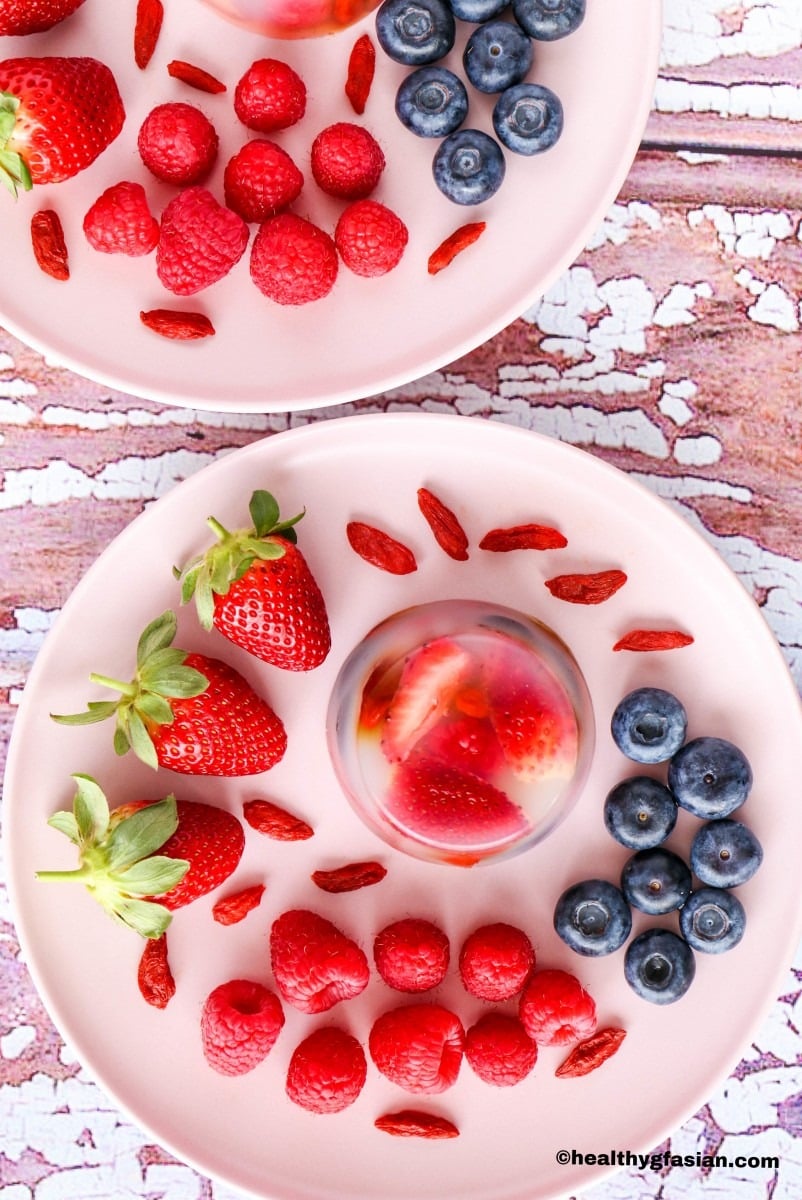
Nutritional Values and Health Benefits of Coconut Water
Coconut water has very little cholesterol. Likewise, it is an excellent source of dietary fiber, magnesium, potassium and manganese. Besides, it is a good source of vitamin C, vitamin B2 (riboflavin), calcium, phosphorus and selenium. It is also a low sugar alternative for other sugary drinks and naturally contains high level of electrolytes.
The many health benefits of coconut water may include:
- Help rehydrate the body;
- Lower blood pressure and improve heart health;
- Sustain muscle relaxation;
- Aid in weight loss;
- Cleanse and detox the body; and
- Reduce fatigue and boost energy.
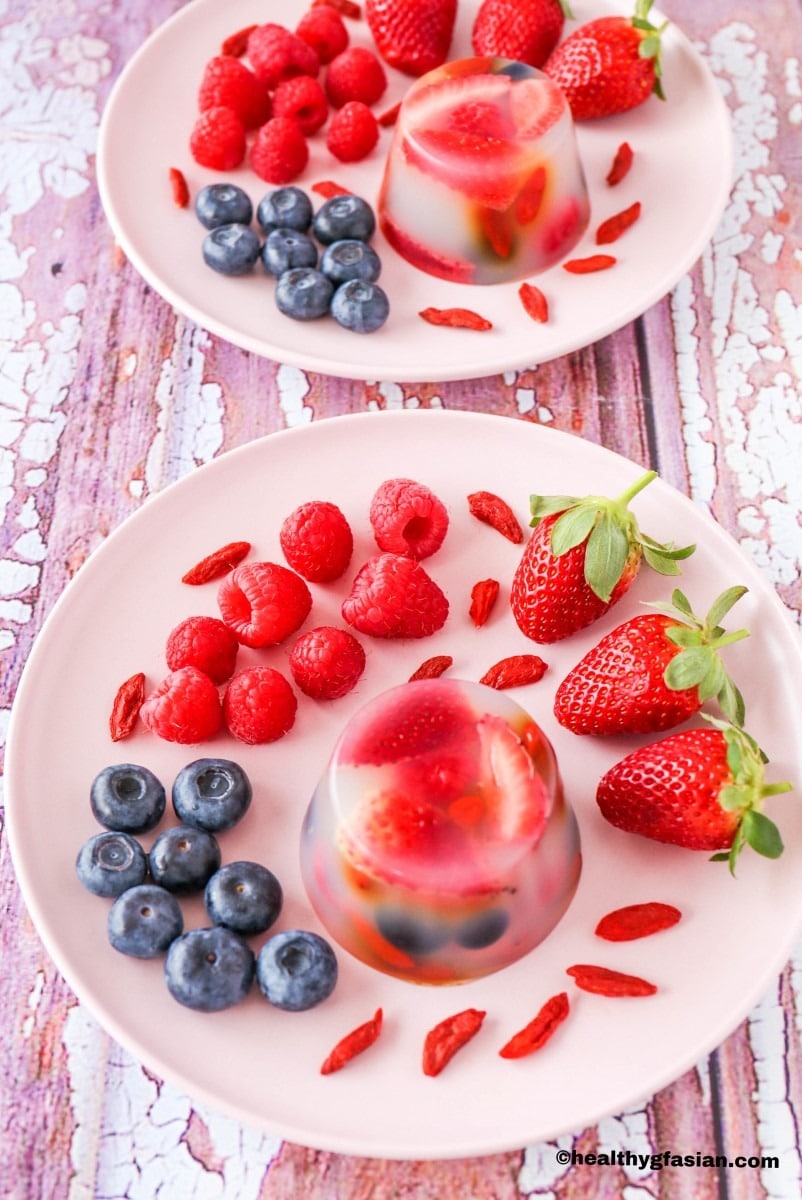
Nutritional Values and Health Benefits of Berries
Berries belong to a large group of farm grown or wild grown fruits. That include blueberries, strawberries, raspberries, gooseberries, mulberries, cranberries, bilberries, loganberries, blackcurrants and redcurrants. Likewise, berries contain phytonutrients called bioflavonoids, specifically anthocyanins, flavonols, ellagic acid and resveratrol. These are powerful antioxidants that are responsible for the many health benefits of berries. And also provide them with their broad range of colours. Moreover, berries contain lots of water, dietary fiber and vitamin C. As a result, many people refer to berries as super food.
The many health benefits of berries may include:
- Eliminate free radicals in the body and protect cells from damage;
- Anti-inflammatory properties that may ease rheumatoid arthritis;
- Promote healthy bones;
- Help manage diabetes;
- Lower risks of age related neurological disorders like Alzheimer’s disease and dementia;
- Promote eye health and lower risks of macular degenerative disease;
- Maintain healthy blood pressure and promote heart health;
- Reduce risks of cancer like colon and stomach cancer;
- Support healthy hair and skin;
- Assist in weight loss; and
- Lowering cholesterol level.
Goji berries, also called wolf berries in China, have the same health benefits as berries. They also associate goji berries with long life, help boost fertility, detoxify the liver, improve energy level and elevate mood.
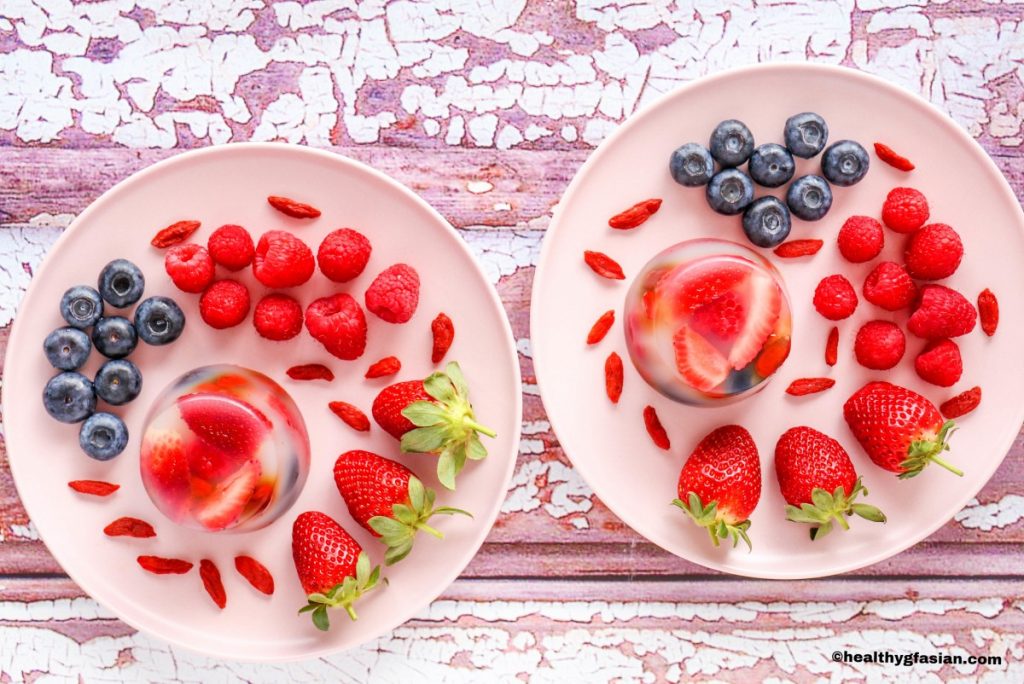
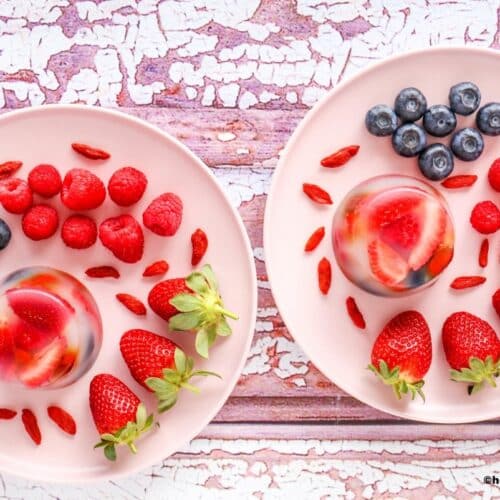
Coconut Water & Mixed Berries Jelly
Ingredients
For the Jelly:
- 1.5 litres coconut water
- 3 tablespoons agar agar powder 2½ tablespoons for softer texture
- 2½ tablespoons stevia
- 200 g blueberries washed
- 200 g raspberries washed
- 250 g strawberries washed cut into quarters
- 30 g dried goji berries
For the Garnish:
- 1 cup strawberries washed
- ½ cup raspberries washed
- ½ cup blueberries washed
- ¼ cup dried goji berries
Instructions
- Place and divide all the berries into 12 mini non-stick pudding moulds (8 litre) or jelly moulds or any small bowls. Fill up to half full.
- Add the all the coconut water and agar-agar powder into small pot, whisk and combine well.
- Bring to a boil and simmer on low heat. Stir until the agar agar powder have melted and thickened. Turn off the heat.
- Pour the mixture into the berries filled mini non-stick pudding moulds (8 litre) or jelly moulds or any small bowls used.
- Chill in the refrigerator for about 2 hours or until set and cooled.
- Remove the jelly from the mould by running a thin smooth edged plastic knife or any small knife, around the sides of the mould.
- Serve the jelly with some extra berries.
Recommended Products
Notes
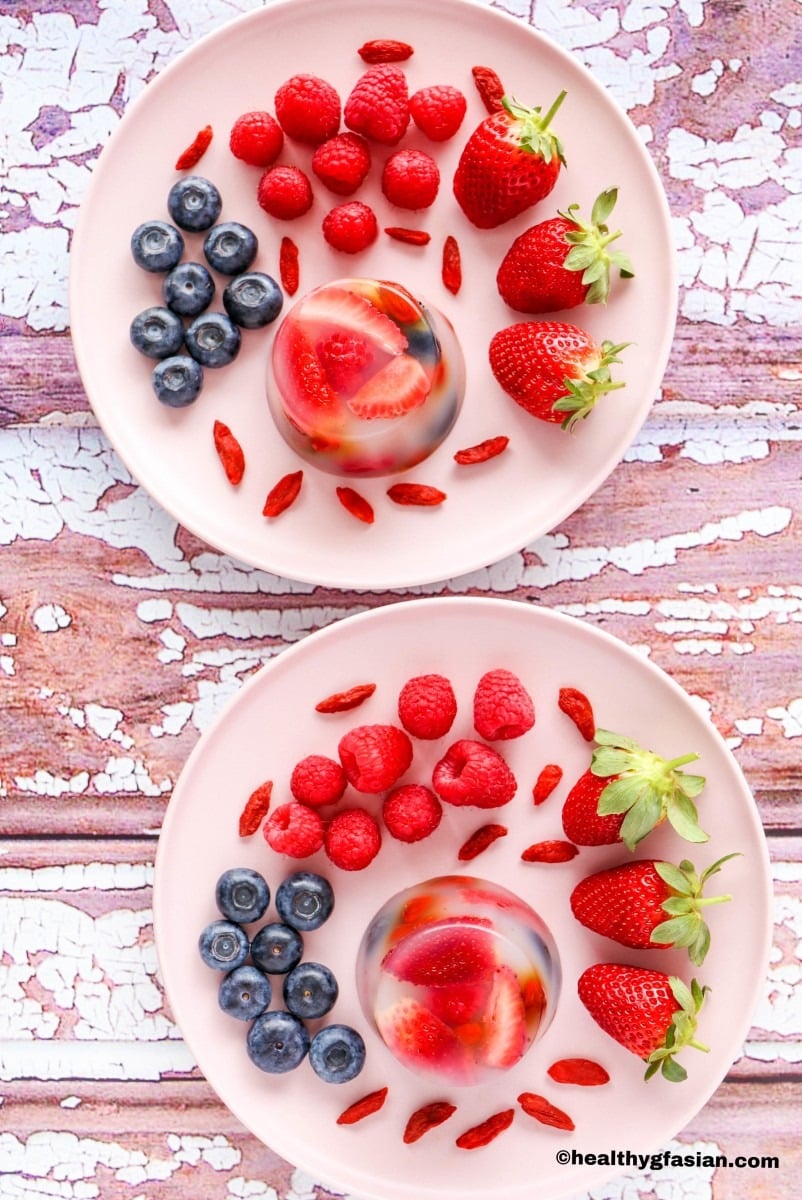




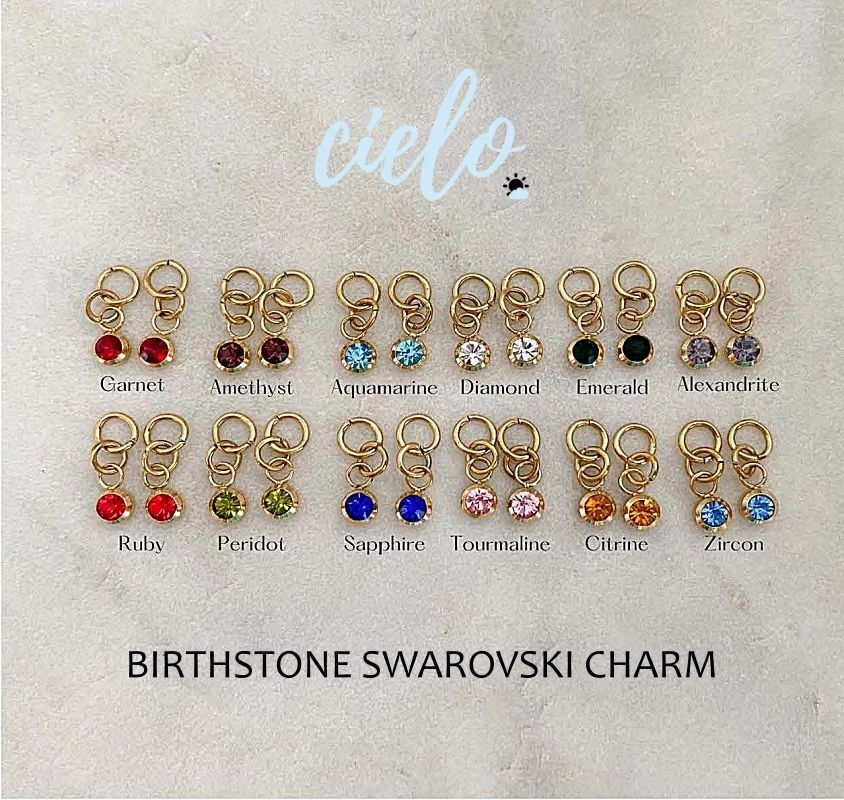

Love these refreshing and fruity Jelly and will definitely be making them again.
Thanks for your nice comment and good ratings. 🙂
How do you store these? Will they stay good?
You can store these Jelly in an airtight container in the refrigerator for up to 3 days.